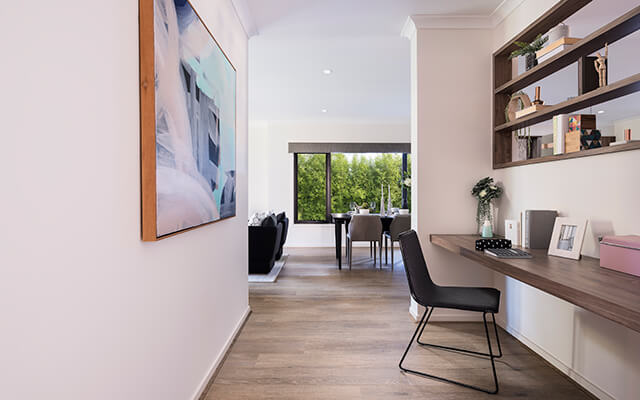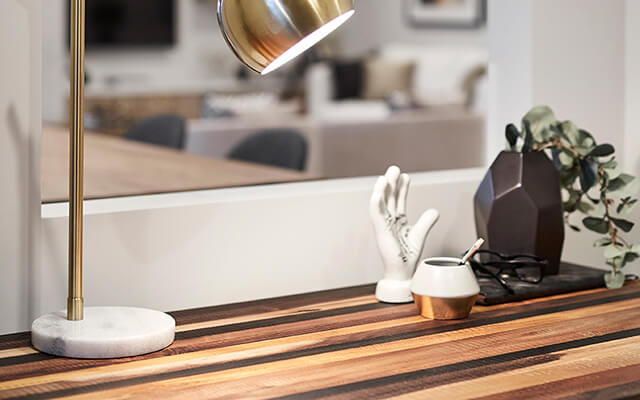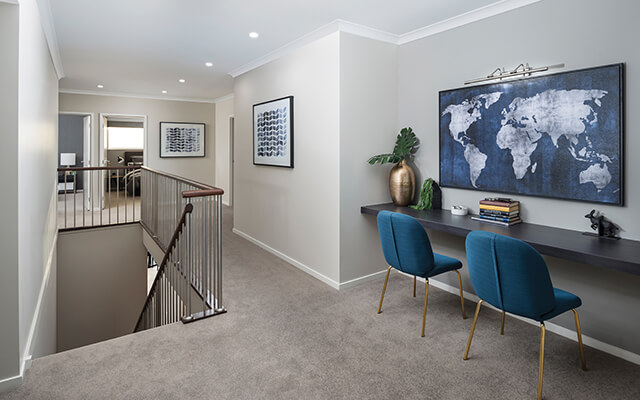BUILD WITH CONFIDENCE FIND OUT MORE
Top 5 things to make a perfect study or home office

Want to set the perfect study or home office? Here are the top five must-haves to help you create a workspace that is both practical and stylish.
1. A comfortable desk
A functional workspace starts with a good desk. When selecting a desk, think about the size and shape of the room and the amount of desk space you’ll need. If you do the majority of your work on a computer, a basic computer or student desk may be sufficient, however if you need space for books, notepads or other items, a corner or hutch desk may be a better option.
It’s also important to consider the ergonomics of the desk. If multiple people will be using the desk or you like to alternate between sitting and standing while working, an adjustable desk or a sit-stand station could be a good option. It’s also important to select an easily adjustable chair that will be comfortable to sit in for long periods of time.
2. Smart and stylish storage
It’s rare to find someone who can work at their optimum in a cluttered environment, so it’s a good idea to invest in some smart and stylish storage options.
The key to selecting the best storage is to think about how often you use the items in your study. Items you use every day should be within very easy reach, items you use maybe once a week should be out of sight but still easy to access when needed, and items you use every so often should be stored away in labelled boxes or drawers so they’re out of sight but can still be found quickly when needed.
It’s also worth investing in some other stationery items that will help you stay organised, like a document tray for any letters or bills you still need to action, a filing system to archive old documents and some cable ties to keep your electronics looking neat and tidy.
3. Carefully selected lighting
You’re going to be spending a significant amount of time in your study, researching topics online, looking for someone “who can write my research paper for me”, trying to improve your academic performance,or spending time in home office staring at a computer screen, so it’s important to pay some thought to the lighting in the room, as a poor lighting scheme can be detrimental to your health potentially causing headaches and eye strain.
An effective lighting scheme should be versatile enough to create a comfortable workspace whatever the time of day (i.e. the natural light in the room at 9am is very different to what it is at 8pm).
Start by thinking about how the natural light flows in the room. It’s usually a good idea to place the desk close to the window to harness the natural lighting, provided you have good blinds or shutters to block out the sun when it gets too intense. You can then use a combination of ceiling lights, table and floor lamps emitting light at various heights and angles to allow you to easily customise the lighting to suit the time of day.
4. An inspiring colour scheme
Colour is thought to have a significant impact on our mood, so devising a colour scheme that will inspire you to do your best work could go a long way. While colour may evoke different feelings based on your individual personality or culture, here’s as general guide of how some colours may impact the mood of your workspace:
- Blue: typically has a calming and relaxing effect.
- Green: can have a serene and restful effect, while still holding some warmth and a connection to nature.
- Red: raises energy and excitement.
- Yellow: brightens your mood and increases energy.
- Purple: a rich and dramatic colour that can create a sense of luxury and is also often associated with creativity.
- Orange: can create a sense of excitement and enthusiasm.
- Pink: can promote feelings of love and playfulness.
If you want to inject a little colour into the room but don’t want to go as far as painting the walls, try injecting you favourite tones through some carefully selected artwork, furnishings or stationery.
5. Some finishing touches
Finally, you need to think about the finishing touches that will complete the space. Take these ideas for example:
- If you have floorboards or tiles in your study, consider if adding a rug to provide a softer and more comfortable floor surface would be suitable.
- Add a TV or speaker if you work better with some background noise.
- Inject a touch of nature and a little fresh air with an indoor plant.
- Add a pin, magnet or white board so you can keep all your notes and other reminders in easy sight.
- Make the most of vertical space by installing some floating shelves.
- Hang some inspiring artworks around the room that you’ll enjoy looking at when you take a short break.
Your trusted Melbourne Home Builder – Dennis Family Homes – A Family Building Homes for Families


